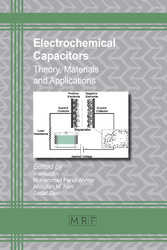Suchen und Finden
Cover
1
Front Matter
2
Table of Contents
6
Theory, Fundamentals and Application of Supercapacitors
8
1. Introduction
9
2. Energy needs and energy storage devices
10
3. Breakthrough in supercapacitor research
11
4. Energy storage principles: EDLC Vs pseudocapacitance
12
5. Design of Supercapacitor
13
5.1 Electrode materials
13
5.1.1 Carbon and allied materials
13
5.1.2 Conducting polymers
14
5.1.3 Metal oxides
15
5.1.4 Hybrid electrode
16
5.1.5 Mixed metal oxide electrodes
16
5.2 Electrolyte
16
5.2.1 Aqueous electrolytes
16
5.2.2 Organic electrolytes
17
5.2.3 Ionic liquid electrolytes
17
5.3 Separator
17
5.4 Different analytical techniques used for the analysis of supercapacitors
17
5.4.1 Cyclic voltammetry (CV)
17
5.4.2 Chronopotentiometry
18
5.4.3 Power density (P) and energy density (E)
18
Conclusions
19
References
19
Metal Oxides/Hydroxides Composite Electrodes for
29
1. Introduction
31
2. Classification of supercapacitors
34
2.1 Electric double-layer capacitors
34
2.2 Pseudocapacitors
34
2.3 Hybrid capacitors
35
2.3.1 Composite
35
2.3.2 Asymmetric hybrids
35
2.3.3 Battery type
35
3. Advantages and challenges of supercapacitors
38
3.1 High power density
38
3.2 Long cycle life
38
3.3 Long shelf life
38
3.4 Wide range of operating temperature
38
3.5 High efficiency
39
4. Disadvantages of supercapacitors
39
4.1 Low energy density
39
4.2 High cost
39
4.3 High self-discharging rate
39
4.4 Industrial standards for commercialization
39
5. Electrode materials for supercapacitors
40
6. Strategies to enhance the performance of supercapacitor
40
7. Factors affecting the performance of metal oxides/hydroxide based supercapacitor electrodes
41
7.1 Crystallinity
41
7.2 Crystal structure
42
7.3 Specific surface area
42
7.4 Particle size
42
7.5 Morphology
43
7.6 Electrical conductivity
43
7.7 Electrode mass loading
44
8. Metal oxide/hydroxides based supercapacitor electrodes
44
8.1 Ruthenium oxide based supercapacitors
44
8.1.1 Ruthenium oxide based composites
46
8.1.1.1 Ruthenium oxide /Carbon based composites
46
8.1.1.2 Ruthenium oxide /Polymer composites
47
8.2 Manganese Oxide based supercapacitors
48
8.2.1 Challenges for manganese oxide electrodes
49
8.2.1.1 Dissolution problem
49
8.2.1.2. Poor electrical conductivity and low surface area
50
8.2.2 Manganese oxide based composites
50
8.2.3 Manganese Oxide /Polymer composites
51
8.3 Nickel oxide based supercapacitors
52
8.4 Cobalt oxides/hydroxides based supercapacitors
53
8.5 Other metal oxides/hydroxides
55
Conclusion
56
Acknowledgement
56
References
56
Activated Carbon/Transition Metal Oxides Thin Films for
70
1. Introduction
71
2. Activated carbon
73
3. Hybrid supercapacitor
76
3.1 The behavior of various metal oxides with AC
80
3.1.1 Ruthenium oxide
80
3.1.2 Manganese oxide
80
3.1.3 Nickel oxide
80
3.1.4 Cobalt hydroxide
80
3.1.5 Vanadium oxide
80
3.1.6 Graphene oxide
81
Conclusion
81
References
81
Ultrasonic Assisted Synthesis of 2D-Functionalized
100
1. Introduction
101
2. Experimental
103
2.1 Formation of functionalized graphene oxide@ PEDOT composites
103
2.2 Instrumentation
104
3. Results and discussion
104
Conclusions
110
References
111
Advanced Supercapacitors for Alternating Current
114
1. Introduction
115
2. Macro-Supercapacitors or Supercapacitors for ac line filtering
116
3. Micro-supercapacitors for ac line filtering
122
4. Flexible-supercapacitors for ac line filtering
133
5. Printable supercapacitors for ac line filtering
137
6 Conclusion and perspectives
139
References
141
High-Performance Polymer Type Capacitors
146
1. Introduction
147
1.1 Electrochemical capacitors (Supercapacitor)
148
1.2 High-performance polymers (HPP) [ ]
152
2. HPP Type separators/electrolytes/substrates in supercapacitors
154
2.1 Fluorinated type polymers and their composites
154
2.2 Nonfluorinated polymers and their composites
159
2.2.1 Polyimides with inorganics
167
2.2.2 Polyimide (PI)/Al2O2 applications
168
2.2.3 Polyimide (PI)/SiO2applications
169
2.2.4 Polyimide (PI)/barium titanate (BaTiO3) applications
170
2.2.5 Polyimide (PI)/Cupper (Cu) based applications
172
2.2.6 Polyimide/ SnO2applications
173
2.2.7 Polyimide/Zr based applications
174
2.2.8 Polyimide/TiC, TiO2 applications
175
2.2.9 Polyimide/carbon nanotubes and carbon nanofibers
176
2.2.10 Polyimides/other inorganic ingredients
178
2.2.11 Other Nonfluorinated Polymers and their inorganic composites
180
2.3 Fluorinated and nonfluorinated polymers and their composites
182
2.4 Polyarylene ethers and their composites
186
2.5 Polyvinylpyrrolidone (PVP) based applications
189
2.6 Carbohydrate polymers
192
3. Challenges and future directions
195
Conclusions
199
References
200
Hydrothermal Synthesis of Supercapacitors Electrode Materials
216
1. Introduction
217
2. Supercapacitor
218
2.1 Types of supercapacitors
218
2.2 Evaluation of supercapacitor performance
219
2.3 Challenges to supercapacitors
220
2.4 Applications of supercapacitors
221
3. Hydrothermal Method
221
3.1 What is hydrothermal technique?
221
3.2 Carbonaceous materials
222
3.3 Metal oxides/hydroxides
223
3.3 Composites
228
Conclusion
233
Acknowledgement
234
References
234
Electrochemical Super Capacitors Fabricated by the
243
1. Introduction
244
1.1 Principle of supercapacitors
245
1.2 Layer-by-layer assembly (LbL) techniques
246
1.2.1 Dip assisted, spin assisted and spray assisted
247
2. Appropriate materials for supercapacitors
248
2.1 Graphene and graphene oxide (GO)
248
2.2 Polyaniline (PANI)
249
2.3 Metal hydroxides-cobalt based capacitors
249
2.4 CNT
250
2.5 Metal oxides
250
2.6 Cellulose nanofibers (CNFs)
250
2.7 Conducting polymers
251
2.8 Hybrid materials
251
3. Supercapacitors fabricated by LbL assembly
251
3.1 Reduced GO-PANI composite
251
3.2 GO-propylpyridinium silsesquioxane chloride polymer
254
3.3 Reduced GO-MnO2 nano?owers
255
3.4 Reduced GO-CNFs- PANI
258
3.5 Reduced GO-MnO2-SILAR method
260
3.6 Reduced GO-magnetite
262
3.7 Polymer film
262
Conclusion
264
References
264
Graphene-based Composites: Present, Past and Future for Supercapacitors
270
1. Introduction and background
271
2. Graphite, graphite oxide and graphene
274
3. Graphene-based composites for supercapacitors
277
3.1 Energy applications
277
3.2 Past, present, and future
278
4. Conclusion
288
References
289
Keyword Index
295
About the Editors
296
Alle Preise verstehen sich inklusive der gesetzlichen MwSt.







